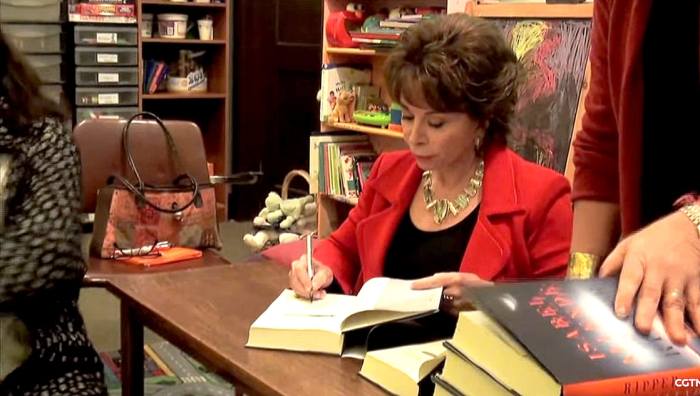Isabel allende la mujer del juez – Isabel Allende’s “La Mujer del Juez” is a captivating novel that delves into the complexities of human experience, exploring themes of love, loss, justice, and the resilience of the human spirit. Through the lens of Irene Beltrán, the novel’s protagonist, Allende weaves a poignant tale that exposes the deep-rooted social and political issues of her time.
Allende’s writing style is characterized by its magical realism, symbolism, and feminist undertones. She seamlessly blends the ordinary with the extraordinary, creating a rich tapestry that captivates the reader’s imagination. Her characters are vividly drawn, each with their own unique struggles and aspirations.
Isabel Allende’s Writing Style
Isabel Allende’s distinctive writing style combines elements of magical realism, symbolism, and feminist themes to create a captivating and immersive narrative experience. Her prose is characterized by its lyrical beauty, emotional depth, and exploration of complex social and political issues.
Magical Realism
Magical realism is a defining feature of Allende’s work. She seamlessly weaves fantastical elements into the fabric of everyday life, blurring the boundaries between the real and the surreal. In “The House of the Spirits,” for example, the patriarch of the Trueba family possesses the ability to levitate, while the protagonist, Clara, communicates with spirits.
Symbolism
Allende’s writing is rich in symbolism. Objects, colors, and characters often carry multiple layers of meaning. In “Of Love and Shadows,” the color red symbolizes both passion and violence, while the character of Irene Beltrán represents the resilience and strength of women in the face of adversity.
Feminist Themes, Isabel allende la mujer del juez
Feminism is a central theme in Allende’s work. She explores the experiences of women in patriarchal societies, highlighting their struggles and triumphs. Her female characters are often strong, independent, and defiant, challenging traditional gender roles.
Major Themes in “La Mujer del Juez”

In “La Mujer del Juez,” Isabel Allende explores several central themes that critique social and political issues prevalent during the time period in which the novel is set. These themes include:
- Political Oppression and Violence:Allende depicts the brutality and repression of the military dictatorship in Chile, highlighting the suffering and injustice endured by its victims.
- Gender Inequality and Female Empowerment:The novel examines the patriarchal society of the time, challenging traditional gender roles and empowering women through the portrayal of strong and resilient female characters.
- Historical Memory and Trauma:Allende delves into the importance of confronting and remembering the past, as well as the psychological and emotional impact of trauma on individuals and society.
- Love and Resilience:Despite the harsh circumstances, Allende explores the power of love and the resilience of the human spirit in the face of adversity.
Character Analysis of Irene Beltrán

Irene Beltrán, the protagonist of Isabel Allende’s “La Mujer del Juez,” is a complex and multifaceted character. Her experiences and relationships profoundly shape her development throughout the novel.Initially, Irene is portrayed as a strong-willed and independent woman. She has endured the hardships of poverty and political turmoil, and she is determined to make a better life for herself and her family.
However, her marriage to Judge Pelayo del Casal proves to be a source of both happiness and pain.
Irene’s Relationship with Judge Pelayo del Casal
Irene’s relationship with Pelayo is initially characterized by love and mutual respect. However, as the novel progresses, Irene begins to realize that Pelayo is not the man she thought he was. He is a man of contradictions, capable of great kindness and cruelty.
Irene’s love for Pelayo is tested when she discovers his involvement in the political repression of the Pinochet regime.Irene’s relationship with Pelayo also shapes her political consciousness. Through her experiences with Pelayo, Irene comes to understand the true nature of the Pinochet regime and its devastating impact on the Chilean people.
This understanding leads Irene to become more politically active and to fight for justice and human rights.
Irene’s Relationships with Other Characters
In addition to her relationship with Pelayo, Irene also has important relationships with other characters in the novel, including her mother, her sister, and her daughter. These relationships provide Irene with support and strength during difficult times.Irene’s relationship with her mother is particularly important.
Her mother is a strong and independent woman who has always been there for Irene. Irene’s mother provides her with guidance and support, and she helps Irene to maintain her sense of self-worth.Irene’s relationship with her sister is also important.
Her sister is a more traditional woman who has chosen to conform to the expectations of society. Irene’s relationship with her sister is complex, but she ultimately comes to understand and accept her sister’s choices.Irene’s relationship with her daughter is the most important relationship in her life.
Her daughter is the center of her world, and she is determined to give her daughter the best possible life. Irene’s love for her daughter gives her the strength to overcome the challenges she faces.
Historical Context of the Novel: Isabel Allende La Mujer Del Juez
La Mujer del Juezis set against the backdrop of Chile’s tumultuous political and social landscape in the mid-20th century. The novel spans the period from the 1940s to the 1970s, a time marked by political instability, social upheaval, and economic crisis.
The novel’s events unfold during the presidency of Salvador Allende, a socialist who was democratically elected in 1970. Allende’s government implemented a series of progressive reforms, including land redistribution and nationalization of industries, which met with strong opposition from the conservative right-wing.
Political and Social Climate
The political climate in Chile during this period was highly polarized. The right-wing, led by the National Party, opposed Allende’s reforms and sought to undermine his government. The left-wing, including the Communist Party, supported Allende but was often divided on the best course of action.
The social climate was also tense. The gap between the rich and the poor was growing, and many Chileans felt disenfranchised and marginalized. The country was plagued by poverty, unemployment, and political violence.
Influence on the Novel
The political and social climate of the time had a profound influence on the events and characters in La Mujer del Juez. The novel explores the impact of political instability on personal relationships, the challenges faced by women in a patriarchal society, and the search for justice in a time of turmoil.
Symbolism and Motifs in the Novel
Isabel Allende’s “La Mujer del Juez” employs a rich tapestry of symbols and motifs that enhance its narrative depth and emotional resonance. These elements play a pivotal role in conveying the novel’s themes, underscoring the characters’ experiences, and creating a multilayered exploration of love, justice, and the human condition.
The Garden
The garden, meticulously tended by Irene Beltrán, serves as a symbol of her inner world. Its beauty and tranquility contrast with the chaos and violence of the outside world, representing her desire for peace and escape. As the garden flourishes under her care, it becomes a refuge where she finds solace and connection with nature.
The Piano
Irene’s piano is an extension of her soul. Its melodies express her unspoken emotions, allowing her to communicate her pain, longing, and resilience. The piano becomes a symbol of her artistic expression and a channel for her to process her traumatic experiences.
The Judge’s Absence
The prolonged absence of Irene’s husband, the judge, symbolizes the breakdown of justice and order in a society torn apart by political turmoil. His disappearance represents the failure of the judicial system to protect the innocent and uphold the rule of law.
The Color Red
Red is a recurring motif throughout the novel, evoking passion, violence, and the transformative power of change. It appears in Irene’s clothing, the bloodstains on the judge’s shirt, and the fiery sunsets that illuminate the horizon. The color symbolizes the intensity of Irene’s emotions, the brutality of the conflict, and the possibility of redemption.
Critical Reception and Legacy of the Novel

Upon its release in 1974, “La Mujer del Juez” garnered widespread critical acclaim for its poignant portrayal of female empowerment and its unflinching exploration of societal norms. Critics lauded Allende’s skillful storytelling, evocative prose, and her ability to craft complex and relatable characters.
Novel’s Lasting Impact
The novel has had a lasting impact on literature and society, becoming a seminal work of feminist literature and a testament to the strength and resilience of women. It has been translated into over 30 languages and has sold millions of copies worldwide, cementing its status as a classic of contemporary fiction.
Beyond its literary merits, “La Mujer del Juez” has played a significant role in shaping societal discourse on gender equality and women’s rights. The novel’s exploration of domestic violence, sexual assault, and female agency has resonated with countless readers, raising awareness about these critical issues and challenging traditional gender roles.
FAQs
What is the significance of Irene Beltrán as a character?
Irene Beltrán is the protagonist of “La Mujer del Juez” and represents the strength and resilience of women in the face of adversity. Through her experiences, Allende explores themes of female empowerment, independence, and the search for justice.
How does Allende use magical realism in “La Mujer del Juez”?
Allende incorporates magical realism into the novel to create a surreal and dreamlike atmosphere. She blurs the lines between reality and fantasy, allowing the characters to experience extraordinary events that reflect their inner struggles and desires.
What are the main social and political issues explored in “La Mujer del Juez”?
Allende tackles a range of social and political issues in the novel, including gender inequality, political corruption, and the search for justice. She exposes the injustices and inequalities faced by women and marginalized communities.